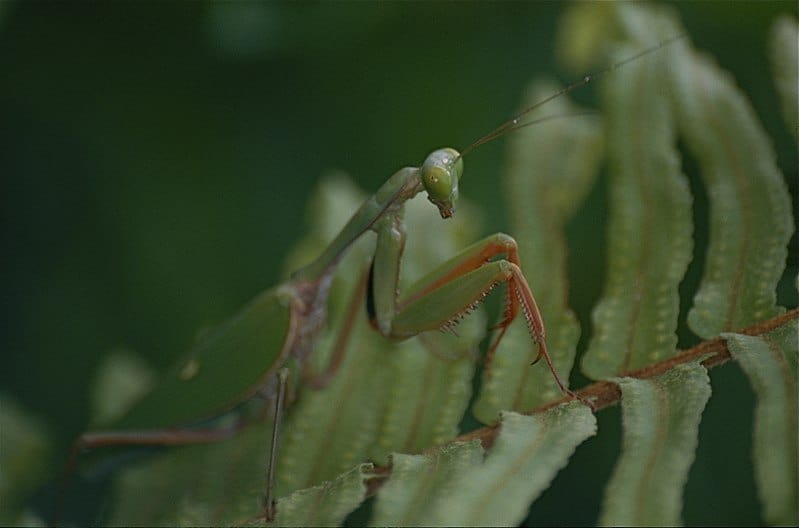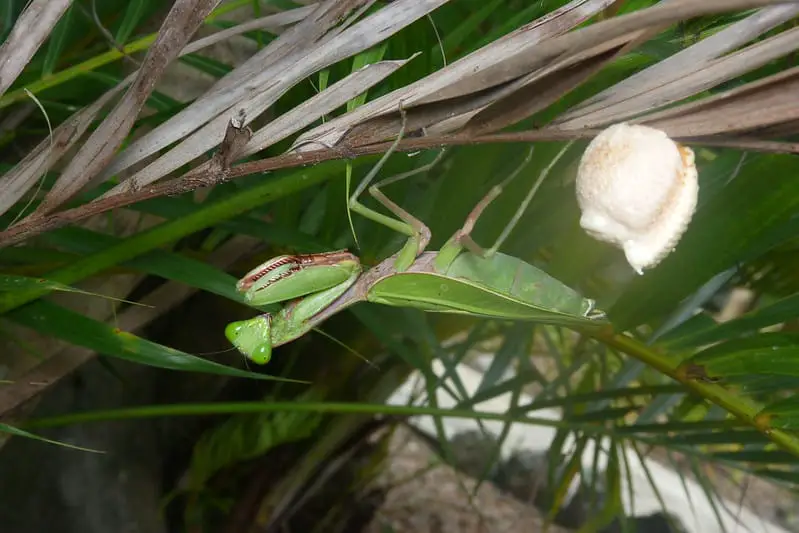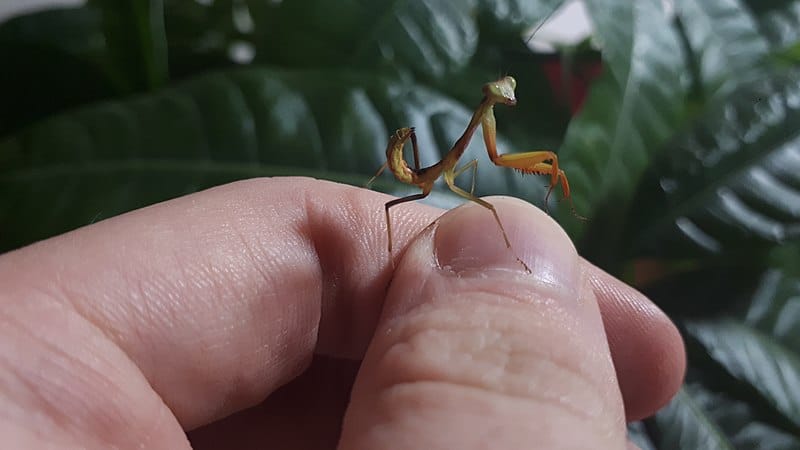The Giant Rainforest Mantis (Hierodula majuscula) is a beautiful mantis with a classical appearance in a big package.
It’s famous for being one of the biggest mantids in Australia, and it’s also a fantastic pet for hobbyists.
If you’re thinking about getting the Giant Rainforest Mantis as a pet, or if you simply want to know more about them, this article has everything you need to know about this beautiful insect!

Giant Rainforest Mantis Care Sheet
| Name of species | Hierodula majuscula |
| Family | Mantidae |
| Common name | Giant Rainforest Mantis |
| Type | Macropterous |
| Native location | Northern Australia |
| Temperature | 75°F to 82°F |
| Humidity | 70% and 80% |
| Size | 2.8 to 3.9 inches (7 to 10 cm) |
| Diet | Small and medium-sized insects |
| Lifespan | 12 months |
| Experience level | Beginner |
Giant Rainforest mantis Overview

The Hierodula majuscula is popularly known as the Giant Rainforest Mantis and the Australian Rainforest Mantis by hobbyists.
It’s found in the rainforest climates of Australia, especially in the north. It has long wings that enable it to fly, so it’s classified as macropterous.
It’ll eat any insects that are small enough for them to catch; with this species being on the larger side, this means that they can catch and eat several medium-sized insects and even some small reptiles.
Appearance & Variations
The beautiful Giant Rainforest Mantis has a bright green color with red and black tones under its face and front legs.
The underside of its thorax is purple, and nymphs can display different tones from reddish brown to olive green until they mature into their grass green color.
They exhibit sexual dimorphism, with females being bigger and bulkier than males. The easiest way to tell them apart is their wings. The Giant Rainforest Mantis’ long wings are shorter than the abdomen in females but go beyond the abdomen in male specimens.
Price
The Giant Rainforest Mantis has varying prices depending on where you get it and how available it is at the moment.
In any case, they’re not overly expensive pets, so don’t worry about going out of budget if you’re interested in getting one.
The nymphs cost between $15 and $35, while adults range between $20 and $45 depending on size and sex.
Behavior and Temperament
The Giant Rainforest Mantis hunts by ambush. It stays still and waits for its prey to approach to take it by surprise. It’s also a vicious hunter taking on opponents that sometimes are equal in size, so it’s always exciting to watch it feed.
This mantis will often feed on its own kind, so you shouldn’t keep more than one specimen in the same enclosure.
You can handle this large mantis as long as you’re careful not to hurt it, but take into consideration that males are excellent fliers, so make sure it doesn’t escape or fly into dangerous objects such as fans. Also, they’re not keen on being handled, so don’t do it too often, or it’ll spend most of its time stressed.
They’re not defensive or aggressive towards humans but they can bite if they feel particularly threatened. Luckily, their bites are harmless to humans because they are not venomous.
Caring for a Giant Rainforest Mantis

Temperature and Humidity
The Giant Rainforest Mantis lives in the Australian rainforest, where temperatures and humidity are high. It’s most comfortable in temperatures between 75°F and 82°F. You should also make sure it lives in humidity levels between 70% and 80%, which can be achieved through misting the enclosure.
With such high temperatures and humidity, ventilation is also important.
Substrate
Your Giant Rainforest Mantis needs the right kind of substrate to hold all that moisture. Mixtures with peat moss and coconut fiber are ideal for retaining humidity, but you don’t need too much since it’s not a burrowing species.
1 – 2 inches of substrate are enough to keep the mantis healthy, just make sure to clean it frequently to avoid fungi and bacterial formation.
Tank
The Giant Rainforest Mantis needs a tank with good ventilation to reduce the chance of mold formation and keep it healthy, so ensure there are enough ventilation holes to keep good airflow.
The enclosure’s size is also important, so the tank should be at least twice as tall, three times as wide, and three times as long as the mantis; however, getting a bigger tank will improve its comfort.
It’ll need a twig or a branch placed inside the enclosure to allow the Giant Rainforest Mantis to hang from it during molts, and other types of decoration such as fake plants are ideal but not necessary.
Going for a bioactive enclosure is also possible. Though it is more difficult to set up, it’s the ideal way to house your mantis.
Watering
The Giant Rainforest Mantis needs plenty of humidity, so you should mist the soil constantly with water.
It’ll get most of its hydration from the food and droplets found in the enclosure, so you don’t need to place a water dish in the enclosure.
Diet & Feeding
The Giant Rainforest Mantis is a vicious hunter able to take down big prey such as small frogs and geckos in the wild, but it’s comfortably eating different types of insects in captivity.
It has a healthy appetite, so you should feed it one prey every other day and make sure to remove any remains left in the enclosure.
L1 and L2 nymphs can be fed small fruit flies, while L3 to L5 enjoy greenbottle flies and big fruit flies. L6 to adult specimens can eat bluebottle flies, but you can add more insects such as crickets and cockroaches to the diet while adapting feeding frequency to make sure not to overfeed it.
If you notice that the abdomen keeps getting bulkier and bigger, reduce feeding frequencies until it returns to its normal size.
Make sure that you avoid feeding them right after a molt to give their exoskeleton time to harden.
Lifespan & Health
The Giant Rainforest Mantis typically has a lifespan of around a year. Since they do not have to fear predators in captivity, they often reach this lifespan quite easily as long as you properly care for them.
Giant Rainforest Mantis Facts
- The Hierodula majuscula is similar in appearance to the Indian Giant Mantis, another member of the Hierodula genus that lives across the sea on another continent. However, the Indian Giant Mantis doesn’t have the beautiful red and black tones under the front legs that the Giant Rainforest Mantis has, so it’s not too difficult to tell them apart.
- The Hierodula genus is known for taking on big prey. These mantids can even catch prey as large as them, such as geckos and small frogs, so they’re ferocious hunters and fighters. However, these encounters can sometimes end badly for the mantis, so feeding them with such big animals is not recommended if you want to keep them safe.
- The cannibalistic tendencies of the Giant Rainforest Mantis tend to show earlier than in most mantis species. This mantis can start preying on members of its own species when it becomes an L3 nymph. You should separate them into individual enclosures as soon as they reach this developmental stage and ideally earlier.
Final words
The Giant Rainforest Mantis is a beautiful and exciting mantis that’s very suitable for beginners as well as more advanced insect keepers.
If you’re careful about maintaining its humidity levels while simultaneously avoiding mold and bacterial growth, the mantis is going to stay healthy, and it’ll be easy to take care of.
Their ferocious feeding response, large size, and impressive appearance make them excellent pets.
If you don’t really think this species is for you, that’s fine too! There are so many different species that I’m sure there’s one that you’ll love. I recommend that you start off by checking out the Budwing or the European Mantis instead!
- How Long Do American Eskimo Dogs Live? Important Factors and Care Tips - September 29, 2023
- Do American Bulldogs Need Grooming? Essential Tips and Care Guidelines - September 29, 2023
- Do Bengal Cats Enjoy Playing? Essential Tips for Keeping Them Active - September 29, 2023